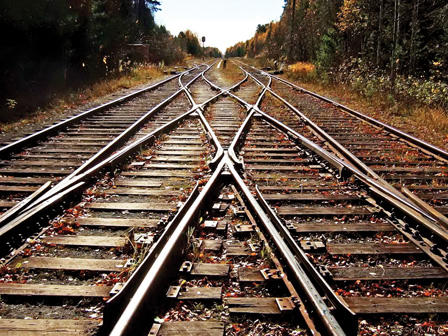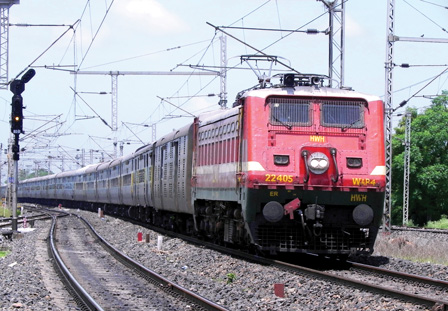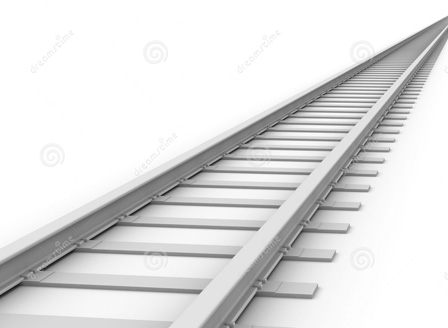Strengthening railway infrastructure and boosting connectivity in North East
Duina Barbarua
 As Railways continue to be the most important medium of mass transportation – being the most preferred and economically viable mode of transportation of goods - and the lifeline of connectivity, it is, therefore, imperative that Railway connectivity in the region be improved and strengthened, providing better, safer and faster links with the rest of the country.
As Railways continue to be the most important medium of mass transportation – being the most preferred and economically viable mode of transportation of goods - and the lifeline of connectivity, it is, therefore, imperative that Railway connectivity in the region be improved and strengthened, providing better, safer and faster links with the rest of the country.
This is vital for growth and development of Assam as well as North Eastern region as a whole.This calls for some immediate measures for improving connectivity and the services provided by the Railways in Assam and the North East as a whole. At present, there is only one railway line linking Assam and the rest of the country. This line passes through Assam–West Bengal border at Srirampur in Kokrajhar district. To ensure better rail connectivity between the North East and the rest of the country, it is essential that there be an alternative Railway line through this stretch.
The State of Assam or for that matter the North East part of India is geographically connected to the rest of the country through a narrow land strip, popularly called ‘Chicken’s Neck’, which has in many ways constrained our connectivity options.The region has about 2600 km of railway lines, mostly in the states of Assam and Tripura. Of late, Meghalaya has entered the Indian rail network with the completion of railway line from Mendipathar in North Garo Hills to Dudhnoi in Goalpara district of Assam. Five of the eight state capitals are yet to be connected by railway while international rail connectivity is non-existent.
Mention may be made of the 257 km Mayanaguri (West Bengal) – Jogighopa (Assam) new Railway line project. The stretch from Coochbehar (West Bengal) to Abhaypuri (Assam) would serve as alternative Railway link for Assam. The Maynaguri–Jogighopa Railway line and in particular, the stretch from Gauripur to Abhaypuri may be commissioned by allocation of adequate resources for completion of the alternative Railway link. The 6 km Tirap-Lekhapani Railway line is needed for efficient and economical access to the Lekhapani Coal mines of Coal India Limited for supply to several upcoming thermal power plants including the 750 MW Bongaigaon Thermal Power Station (BTPS) of NTPC in Salakati, Kokrajhar district. The Gauge Conversion Survey of this line was completed as far back as 2011. The completion of this work would enable efficient exploitation of valuable coal resources of the region and give a boost to thermal power generation.
 Due to the increasing goods traffic flow into the state, the existing Saraighat rail bridge, which is very old, needs to be augmented with another parallel bridge. While a parallel road bridge is under construction at Saraighat, it may be explored if a parallel rail bridge can also be provided there. Also, while there is a road bridge over the river Brahmaputra at Bhomoraguri near Tezpur, there is a need for a railway line from Silghat to Balipara via Tezpur with a Railway bridge over Brahmaputra. This is relevant for strategic reasons also as it will connect the important defence establishments at Tezpur and Arunachal with South Assam. In fact there was an old railway line between Tezpur to a point close to Balipara constructed during the colonial period which has fallen into disuse. This may be revived.
Due to the increasing goods traffic flow into the state, the existing Saraighat rail bridge, which is very old, needs to be augmented with another parallel bridge. While a parallel road bridge is under construction at Saraighat, it may be explored if a parallel rail bridge can also be provided there. Also, while there is a road bridge over the river Brahmaputra at Bhomoraguri near Tezpur, there is a need for a railway line from Silghat to Balipara via Tezpur with a Railway bridge over Brahmaputra. This is relevant for strategic reasons also as it will connect the important defence establishments at Tezpur and Arunachal with South Assam. In fact there was an old railway line between Tezpur to a point close to Balipara constructed during the colonial period which has fallen into disuse. This may be revived.
next
-
The gauge conversion of Baraigram-Durlabcherra Railway line, which has already been sanctioned, is required to be carried out expeditiously as this is the only metre gauge left in Assam. It is good to know that the Central Government has provided requisite funds for the completion of broad gauge rail conversion and construction of railway bridges in Assam. Meanwhile, the N.F. Railway has imposed “Mega Block” for completion of the gauge conversion in the Lumding-Badarpur hill section from 1st October, 2014 and all the works for this project were expected to be completed by 31st March, 2015. During the period of the Mega Block, all railway services across this section, which is the only rail link to Barak Valley, lie suspended. Construction of the Bogibeel Rail-cum-Road Bridge with linking lines between Dibrugarh & North Bank is inordinately delayed. Some other ongoing important railway projects such as: (i) Gauge conversion of Lumding-Silchar-Jiribam & Badarpur-Kumarghat, and (ii) New B.G. line from Tetelia to Byrnihat have been going on for years together. Some of these are in advanced stages of implementation and require last mile allocation of funds to be completed.
The challenges of rail connectivity in the North East is manifold given the tough terrains, logistical issues coupled with the fluid law and order situation, bandh syndrome throwing life out of gear, land acquisition, forest clearance et al. But there can be no excuses for delay in completion of the projects. The projects have to be strictly implemented within a stipulated time frame. This would not only help to restore the socio-economic issues but also bring the region closer to the mainstream by removing the sense of alienation
The doubling of the Railway line stretch between New Bongaigaon and Kamakhya (Guwahati) is urgently required in order to decongest the present Railway line. This may be considered as an extension to the doubling of Railway line stretch between New Jalpaiguri and Samuktala via Cooch Behar. There is a need to modernize and develop the Guwahati Railway Station, with modern passenger facilities and amenities to cater to the growing rush of passengers it regularly faces. This is so as Guwahati is not only the railway gateway but also a transhipment point for many passengers and goods. Kamakhya Railway Station has the potential of becoming the hub for religious tourism, and hence would require up gradation to cater to the ever increasing volume of pilgrims and passengers.
It is also important to upgrade some smaller railway stations, particularly at North Guwahati, Jagiroad and Furkating to meet the local economic requirements and growing public use. The infrastructure at Rangapara Railway Station also needs to be improved as this station serves several defence establishments nearby. As the city of Guwahati has grown by leaps and bounds, it is necessary to enable smooth transportation of goods into the city and its neighbouring region. This may be done by decongestion of goods terminal at New Guwahati by expanding the freight terminal at Azara and opening of a new terminal at Amingaon. The facilities at Changsari terminal may be augmented to attract more goods traffic. This would help in decongestion and growth of Guwahati, the business and commercial hub of the region.With the conversion of the Lumding-Silchar MG track to BG, the meter gauge portion between Mahur to Ditockcherra via Haflong and Jatinga, approximately 50 km has become redundant for North East Frontier Railway. However, this meter gauge section has potential for becoming a beautiful tourist circuit as there is a great scope for the development and marketing of the tourism potential of the Haflong Hills.
There is also a need to improve the quality of train services. It is important to note that some of the longest train journeys affecting lakhs of passengers originate in the region. For example, the trains which originate from Tinsukia/Dibrugarh and travel across the eastern and southern parts of the country right up to Kanyakumari are the longest journeys in the Indian Railways network. Similarly, trains connecting Assam with Mumbai, New Delhi and other parts of the country also perform long journeys. These trains serve poor and middle class passengers largely and aid internal migration, carry patients to health centers and serve the needs of students and personnel of the armed forces. The facilities in these trains which involve journeys of up to five days leave much to be desired.
Connecting all the North East State capitals by railheads will help in transporting people and goods, enhance mobility choices, promote economic development. It will ensure movement of passengers and goods even if there is disruption in surface communication - the only lifeline connecting small towns and villages within the region - and also help to bring about an integrated development of the region to bridge the economic disparity.
There is a growing demand for more frequent services of the Dibrugarh Rajdhani Express (Train No. 12435-12436) which may be increased from the current twice a week to a daily service, in addition to the existing daily Rajdhani train services. New trains to Pune and Mumbai may also be considered. The train services linking Assam with other parts of the country serve the people of the entire North Eastern Region. There is always heavy rush and people of the NER have to wait for months to get a berth or a seat in the long distance trains connecting Dibrugrah/Guwahati with other parts of the country. There is a need to increase the number of trains connecting Guwahati/Dibrugrah with Delhi, Kolkata, Mumbai, Chennai, Bangalore, Hyderabad, Pune, Jaipur and other major cities of the country. Similarly, the number of Rajdhani Express from Assam to Delhi may be increased to two (2) daily as against the one (1) at present – taking into account the fact that it caters to the needs of not one but eight NE States. With extension of the broad gauge line to most parts of Assam, intercity services between different destinations in Assam may be introduced.
Prime Minister Narendra Modi’s recent announcement that the Centre would provide Rs.28,000 crore for laying new railway lines in the North East region may evoke new hope for the tourism and hospitality sectors. But how far this envisaged investment will lead to the improvement of rail network in North East is a matter which can only be assessed in future. Even Modi’s predecessor Dr. Manmohan Singh had announced, while releasing the North Eastern Region Vision 2020 Document, that in order to address a major concern of Indian government infrastructure deficiency so far as north eastern region is concerned, all state capitals in the region would be linked with rail lines. But how far this will be translated into reality is difficult to predict given the tardy progress of some important railway projects in the region.
 Moreover, there is a need for massive investments to create new connectivity infrastructure and upgrade the existing ones. Government alone cannot fulfill these needs and therefore it is important to rope in the private sector – national and international companies and also multilateral agencies to help finance and execute large scale rail, road, air and waterways connectivity projects in the region. Be that as it may, there is a pressing need for consolidating the railway infrastructure and boosting connectivity in the North East. As a step in the right direction, the North East Frontier Railway may be declared as a dedicated zone for the North Eastern States with its headquarters at Guwahati, to give a thrust to railways projects in the region. Bifurcation of the Maligaon-headquartered Northeast Frontier Railway (NFR) is a must if rail services are to improve in the North East.
Moreover, there is a need for massive investments to create new connectivity infrastructure and upgrade the existing ones. Government alone cannot fulfill these needs and therefore it is important to rope in the private sector – national and international companies and also multilateral agencies to help finance and execute large scale rail, road, air and waterways connectivity projects in the region. Be that as it may, there is a pressing need for consolidating the railway infrastructure and boosting connectivity in the North East. As a step in the right direction, the North East Frontier Railway may be declared as a dedicated zone for the North Eastern States with its headquarters at Guwahati, to give a thrust to railways projects in the region. Bifurcation of the Maligaon-headquartered Northeast Frontier Railway (NFR) is a must if rail services are to improve in the North East.
A separate railway zone for the North East is the pressing need of the hour. After all, development of connectivity infrastructure will have huge multiplier effects on the region’s growth besides paving the way for better economic and strategic integration of the region with the rest of the country and also with its neighbouring countries.
The challenges of rail connectivity in the North East is manifold given the tough terrains, logistical issues coupled with the fluid law and order situation, bandh syndrome throwing life out of gear, land acquisition, forest clearance et al. But there can be no excuses for delay in completion of the projects. The projects have to be strictly implemented within a stipulated time frame. This would not only help to resolve the socio-economic issues but also bring the region closer to the mainstream by removing the sense of alienation.
Connecting all the North East State capitals by railheads will help in transporting people and goods, enhance mobility choices, promote economic development. It will ensure movement of passengers and goods even if there is disruption in surface communication - the only lifeline connecting small towns and villages within the region - and also help to bring about an integrated development of the region by removing disparity.


 / 3
/ 3